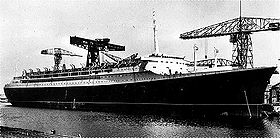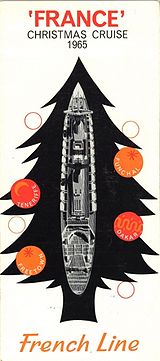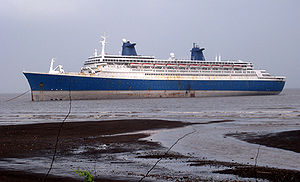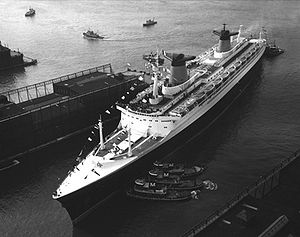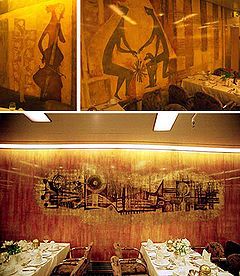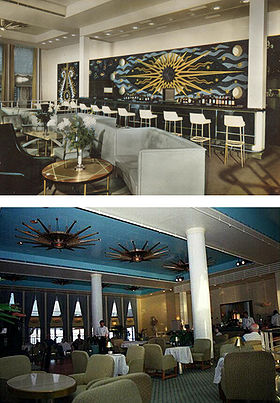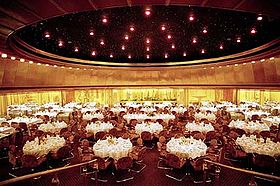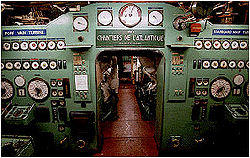SS France (1961)
| 300px SS France docked in Hong Kong, 1974 | |
| Career (France) | |
|---|---|
| Name: | SS France |
| Owner: | Compagnie Générale Transatlantique (French Line) |
| Port of registry: | Le Havre, France |
| Ordered: | 26 July 1956 |
| Builder: | Chantiers de l'Atlantique |
| Laid down: | 7 September 1957 |
| Launched: | 11 May 1960 |
| Christened: |
11 May 1960 by Yvonne de Gaulle |
| Decommissioned: | 25 October 1974 |
| Maiden voyage: | 3 February 1962 |
| Status: | Scrapped in Alang, India 2008 |
| Career (Norway) | |
| Name: | SS Norway |
| Owner: | Norwegian Cruise Line |
| Port of registry: |
Oslo, Norway (1980-1987) Nassau, Bahamas (1987-2003) |
| Ordered: | 26 June 1979 |
| Builder: | Lloyds Werft |
| Christened: |
3 May 1980 by King Olav V |
| Decommissioned: | 23 March 2004 |
| Maiden voyage: | 6 May 1980 |
| Status: | Scrapped Alang, India 2008 |
| General characteristics | |
| Tonnage: |
66,343 GT (gross tonnage) (1961) 70,202 GT (1984) 76,049 GT (1990) |
| Length: | 316.1 m (1,035 ft) |
| Beam: | 33.8 m (110.6 ft) waterline |
| Draft: | 10.8 m (34 ft) |
| Propulsion: |
Geared CEM-Parsons turbines quadruple propeller (1961-1979) / twin propeller (1979-2008) |
| Speed: | 30 knots (59 km/h) approx. |
| Capacity: |
1961-1974 First class: 407 Tourist class: 1,637 1980-1990 - 1,944 passengers 1994-2003 - 2,565 passengers |
| Crew: |
1961-1974 - 1,253 1980-1990 - 875 1994-2003 - 875 |
| Notes: | Cost US $80 million approx. |
SS France was a Compagnie Générale Transatlantique (CGT, or French Line) ocean liner, constructed by the Chantiers de l'Atlantique shipyard at Saint-Nazaire, France, and put into service in February 1962. At the time of her construction in 1960 she was the longest passenger ship ever built. Her length of 316 meters remained unchallenged until the construction of the 345 meter RMS Queen Mary 2 in 2004. France was later purchased by Norwegian Cruise Line (NCL) in 1979, renamed SS Norway and used primarily for cruising. She was sold to be scrapped in 2006, and scrapping was completed in late 2008.
Contents
Characteristics
SS France was the French Line flagship from 1961 to 1974, combining regular transatlantic crossings - six days and nights - with occasional winter cruises, as well as two world circumnavigations.
As the SS Norway she was the flagship of the Norwegian Cruise Line from 1980 to approximately 2001.
Some, like ship historian John Maxtone-Graham, believe that France was purpose built to serve as both a liner and a cruise ship, stating: "Once again, the company had cruise conversion in mind... for cruises, all baffle doors segregating staircases from taboo decks were opened to permit free circulation throughout the vessel."[1] However, others, such as ship historian William Miller, have asserted that France was the "last purposely designed year-round transatlantic supership."[2]
History
Concept and construction
The ship was constructed to replace the line's other ageing ships like the SS Ile de France and SS Liberté, which by the 1950s were considered old and outdated. Without these vessels, however, the French Line had no ability to compete against their rivals, most notably Cunard Line, which also had plans for constructing a new modern liner. It was rumoured that this ship would be a 75,000-ton replacement for their ships RMS Queen Mary and RMS Queen Elizabeth. (This ship would eventually be the 68,000-ton RMS Queen Elizabeth 2.) Further, the United States Lines had put into service in 1952 the SS United States, which had broken all speed records on her maiden voyage, with an average speed of 35.59 knots (65.91 km/h).
At first, the idea of two 35,000-ton running mates was considered to replace Ile de France and Liberté. However, Charles de Gaulle (the future President of France) opined that it would be better for French national pride (which was flagging due to the then ongoing Algerian War of Independence) to construct one grand ocean liner as an ocean-going showcase for France, in the tradition of the SS Normandie. The idea of the liner caused some controversy, with some for and others against it, as its construction would be publicly funded, leading to raucous debates in the French parliament. The dealing lasted three and a half years, and though the letter commissioning the construction was finally signed by the Chairman of the Compagnie Générale Transatlantique, Jean Marie, on 25 July 1956, debate about the form, cost and construction schedule for France lasted a further year.[3]
Beyond the luxuries, the French Line had to also face the realities that transatlantic passenger trade was, at that time, forecast to decline due to increased air travel. Also, costs to operate ships were increasing, mostly due to prices of crude oil. Thus, the new ship would be larger than Ile, but smaller and cheaper to operate than Normandie. She would also only be a two-class liner, which would, like the recently built SS Rotterdam, be able to be converted from a segregated, class restricted crossing mode to a unified, classless cruising mode, thereby allowing the ship to be more versatile in its operations. Despite these requirements, she was still to be the longest ship ever built, as well as one of the fastest, meaning not only an advanced propulsion system, but also a hull design which would withstand the rigours of the North Atlantic at high speed.
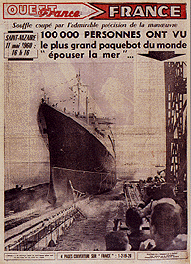
Hull G19 was built by Chantiers de l'Atlantique shipyard, in Saint-Nazaire, France, her keel being laid down on 7 September 1957. She was built in a non-conventional manner: rather than constructing a skeleton which was then covered in steel hull plating, large parts of the ship were prefabricated in other cities (such as Orléans, Le Havre and Lyon). She was built with a unique double bottom that enabled her to carry 8,000 tons of fuel - enough for the trip to New York and back. The hull was fully welded, leading to weight savings, and had two sets of stabilisers fitted.[4]
She was blessed by the Bishop of Nantes, Monseigneur Villepelet, and launched on 11 May 1960, at 4:15 pm, by Madame Yvonne de Gaulle, wife of the President, and was then named France, in honour both of the country, and of the two previous CGT ships to bear the name. By 4:22 pm France was afloat and under command of tugs.[5] President De Gaulle was also in attendance at the launch, and gave a patriotic speech, announcing that France had been given a new Normandie, they were able to compete now with Cunard's Queens, and the Blue Riband was within their reach. In reality, however, the 35 knot speed of United States would prove impossible to beat.
After the launch, the propellers were installed (the entire process taking over three weeks), the distinctive funnels affixed to the upper decks, the superstructure completed, life boats placed in their davits, and the interiors fitted out. France then undertook her sea trials on 19 November 1961, and averaged an unexpected 35.21 knots. With the French Line satisfied, the ship was handed over, and undertook a trial cruise to the Canary Islands with a full complement of passengers and crew. During this short trip she met, at sea, Liberté which was on her way to the shipbreakers.[6]
Service history as SS France
France's maiden voyage to New York took place on 3 February 1962, with many of France's film stars and aristocracy aboard.
On 14 December 1962, France carried the Mona Lisa from Le Havre to New York, where the painting was to embark on an American tour.
From the 13th July to 26 July 1967, France docked at the Île Notre-Dame in Montreal, acting as a secondary French pavilion at the 1967 World's Fair, Expo 67.[7]
She sailed the North Atlantic run between Le Havre and New York for thirteen years. However, by the beginning of the 1970s jet travel was by far more popular than ship travel, and the costs of fuel was ever increasing. France, which had always relied on subsidies from the French government, was forced to take advantage of these more and more.
Using the ship's versatile design to its full potential, the CGT began to send France on more cruises during the winter, which was off-season for the Atlantic trade. One design flaw, however, was revealed when the ship reached warmer waters: her two swimming pools, one each for first and tourist class, were both indoors; the first class pool deep within the ship's hull, and the tourist class pool on an upper deck, but covered with an immovable glass dome. The latter, perhaps, was the more aggravating in hot weather. She also had limited outdoor deck space, with much of what was available protected behind thick glass wind-screens; useful on the North Atlantic, but frustrating when blocking cooling breezes in the tropics. (Queen Elizabeth 2 suffered from a similar design flaw as well.)
Nonetheless, France's cruises were popular, and her first world cruise took place in 1972. Too large to traverse the Panama and Suez Canals, she was forced to sail around Cape Horn and the Cape of Good Hope. That same year, with the destruction of Seawise University (former RMS Queen Elizabeth) by fire in Hong Kong, France became the largest passenger ship in the world in service.
Still, as the opening years of the decade progressed, the cruise market expanded, seeing the construction of smaller, purpose built cruise ships which could also fit through the Panama Canal. Worse, in 1973 the Oil Crisis hit and the price of oil went from $3 US to $12 US per barrel. When the French government, at the end of the Trente Glorieuses, realised that keeping France running would necessitate an additional ten million dollars a year, they opted instead to subsidise the then developing Concorde. Without this government money, the French Line could not operate, and with a press release issued in 1974 it was announced that France would be withdrawn from service on the 25th October that year.
At that, the crew decided to take matters into their own hands: an eastbound crossing on the 6th September, her 202nd crossing, was delayed several hours while the crew met to decide whether to strike then and there, in New York, or six days later outside Le Havre; Le Havre won, and the ship was commandeered by a group of French trade unionists who anchored France in the entrance to the port, thereby blocking all incoming and outgoing traffic. The 1200 passengers aboard had to be ferried to shore on tenders, while approximately 800 of the crew remained aboard. The hijackers demanded that the ship be allowed to continue to serve, along with a 35% wage increase for themselves. However, their mission failed, and the night of the hijacking proved to be the ship's last day of service for the CGT. It took over a month for the stand-off to end, and by the 7th December 1974, the ship was moored at a distant quay in Le Havre, known colloquially as quai de l'oubli - the pier of the forgotten.[6][8]
By that time France had completed 377 crossing and 93 cruises (including 2 world cruises), carried a total of 588,024 passengers on trans-Atlantic crossings, and 113,862 passengers on cruises, and had sailed a total of 1,860,000 nautical miles.[9]
First decommissioning
The mothballing of France was met with dismay by much of the French population, resulting in a song by Michel Sardou, titled Le France.
The ship sat in the same spot for approximately four years, with the interiors, including all furniture, still completely intact. There were no plans to scrap the ship, nor to sell it. However, in 1977 Saudi Arabian millionaire Akram Ojjeh expressed an interest in purchasing the vessel for use as a floating museum for antique French furniture and artworks, as well as a casino and hotel off the coast of the south-east United States. Though he purchased the ship for $24 million, this proposal was never realised, and others were rumoured to have floated, including bids from the Soviet Union to use her as a hotel ship in the Black Sea, and a proposal from China to turn her into a floating industrial trade fair.[6]
In the end, the ship was sold in 1979 to Knut Kloster, the owner of Norwegian Cruise Line for $18 million for conversion by him into the world's largest cruise ship. Just before France was renamed Norway one last marriage was performed aboard the ship at the quay in Le Havre. The wedding was performed by Rev. Agnar Holme, the Norwegian Seaman's Priest. Greg Tighe, Director of Research and Corporate Development for NCL, was married to Lorraine Anne Evering (Tighe) in France's chapel. Witnesses included the ship's Captain, and several members of NCL's management team. This marked the last marriage to be performed aboard the SS France, which had hosted hundreds of weddings over its transatlantic career.
By August of that year Norway was moved to the Lloyd shipyards in Bremerhaven, Germany, where she would undergo renovations to the cost of $80,000,000 US.[10]
Service history as SS Norway
The SS Norway was registered in Oslo, given the call sign LITA (literally meaning "small"), and was re-christened on 14 April 1980, as the first superliner employed exclusively in cruise service. On her maiden call to Oslo, senior steward Wesley Samuels of Jamaica, in the presence of King Olav V, hoisted the United Nations flag as a sign of the ship's international crew.
She began her maiden voyage to Miami that same year, amidst speculation about her future in the cruise industry. France had been built as an ocean liner: for speed; long, narrow, with a deep draft, as well as an array of cabin shapes and sizes designed in a compact manner more for purpose travel than languid cruising. But Norway proved popular, and made the notion of the ship being a destination in itself credible. Her size, passenger capacity, and amenities revolutionized the cruise industry and started a building frenzy as competitors began to order larger ships.
As cruise competition attempted to take some of Norway's brisk business, Norway herself was upgraded several times in order to maintain her position as the "grande dame" of the Caribbean. In September and October 1990, there was the addition of two decks atop her superstructure, adding 135 new suites and luxury cabins. While many ship aficionados believe the new decks spoiled her original clean, classic lines, the new private veranda cabins on the added decks were instrumental in keeping Norway financially afloat during the later years of her operation, as these became a common feature throughout the cruise industry. She received additional refits in 1993 and 1996 in order to comply with the new SOLAS (Safety of Life At Sea) regulations.[11]
Competition eventually overtook Norway, and she even started taking a back seat to other ships in NCL's lineup itself. No longer the "Ship amongst Ships", her owners severely cut back on her maintenance and upkeep. She experienced several mechanical breakdowns, fires, incidents of illegal waste dumping, and safety violations for which she was detained at port pending repairs. Despite the cutbacks, the ship remained extremely popular among cruise enthusiasts, some of whom questioned the owner's actions in light of the continuing successful operation of the RMS Queen Elizabeth 2, which had become a well-maintained rival operating 5-star luxury cruises still for Cunard. In spite of this, the cutbacks continued and problems mounted even as the ship continued to sail with full occupancy. A turbo-charger fire erupted on Norway as she entered Barcelona in 1999, which pulled her out of service for three weeks.[12]
Slated for retirement, Norway sailed out of Manhattan's west side piers for the last time on 9 September 2001, on yet another transatlantic crossing to Greenock, Scotland, and then on to her home port of Le Havre, France. Her passengers would learn of the terrorist attacks on New York and Washington two days later, while in mid-ocean. However, as the cruise industry reeled from the aftermath of the terrorist attacks, her owners decided to place her back into service - operating bargain-basement cruises from Miami, after a brief cosmetic refit that failed to address her mounting mechanical and infrastructure problems.
On 25 May 2003, after docking in Miami at 5:00 a.m., Norway was seriously damaged by a boiler explosion[13] at 6:30 a.m. that killed eight crew members, and injured seventeen, as superheated steam flooded the boiler room, and blasted into crew quarters above through ruptured decking. None of the passengers were affected. On 27 June 2003, NCL/Star decided to relocate Norway, and she departed Miami under tow, although at first NCL/Star refused to announce her destination. However, she headed towards Europe and eventually arrived in Bremerhaven on 23 September 2003. NCL announced that constructing a new boiler was not possible; boiler parts, however, were available to repair her. In Bremerhaven she was used as accommodation for NCL crew training to take their places on board the line's new Pride of America.
Second decommissioning
"Norway[citation needed] will never sail again," it was announced on 23 March 2004, by NCL Chief Executive Colin Veitch. The ship's ownership was transferred to NCL's parent company, Star Cruises.
Due to large amounts of asbestos aboard the ship (mostly in machine and bulkhead areas), Norway was not allowed to leave Germany for any scrap yards due to the Basel Convention. However, after assuring the German authorities that Norway would go to Asia for repairs and further operation in Australia, she was allowed to leave port under tow. It was reported that the art from her two dining rooms, children's playroom, stairtower, and library were removed and placed in storage, to possibly be utilized on board a revitalized SS United States, or another ship in the NCL fleet.[14] However, later photos of the ship at the scrapyards of Alang, India, would prove this statement to be untrue. Norway left Bremerhaven under tow on 23 May 2005, and reached Port Klang, Malaysia on 10 August 2005.
In fact, the ship was sold to an American naval demolition dealer for scrap value in December 2005. After eventually reselling the ship to a scrap yard, the ship was to be towed to India for demolition. However, in light of protests from Greenpeace, potentially lengthy legal battles due to environmental concerns over the ship's breakup, and amidst charges of fraudulent declarations made by the company to obtain permission to leave Bremerhaven, her owners cancelled the sale contract, refunded the purchase price, and left the ship where she was.[15]
SS Blue Lady
The SS Norway was sold in April 2006 to Bridgend Shipping Limited of Monrovia, Liberia, renamed SS Blue Lady in preparation for scrapping. One month later she was again sold, to Haryana Ship Demolition Pvt. Ltd., and was subsequently left anchored in waters off the Malaysian coast after the government of Bangladesh refused Blue Lady entry into their waters due to the onboard asbestos. Three weeks later, the ship began its journey towards Indian waters, though it was announced that she had left Malaysian waters for the United Arab Emirates for repairs, and to take on new crew and supplies.[16][17]
Upon learning of the ship's destination, Gopal Krishna, an environmentalist and an anti-asbestos activist, filed an application before the Supreme Court of India to ensure that the ship, reportedly containing asbestos, complied with the Court's 14 October 2003 order which sought prior decontamination of ships in the country of export before they could be allowed entry into Indian waters. On 17 May 2006, Kalraj Mishra expressed his concern to the Indian Parliament over possible hazards Blue Lady presented, and requested that the government put a halt to the ship's entry. However, as the Indian Supreme Court had lifted any ban on the ship's entry, Blue Lady was anchored 100 km off the Indian coast in mid-July, coming from Fujairah, UAE.[18][19] This also cleared the way for her scrapping at Alang, in Gujarat, pending an inspection of the on-board asbestos by experts from the Gujarat Pollution Control Board (GPCB).[20]
After GPCB chairman, K.V. Bhanujan, said the Board had constituted an experts' committee for inspection, Blue Lady was docked in Pipavav, Kutch District. On the 2nd August 2006, after a five-day inspection, the experts declared the ship safe for beaching and dismantling in Alang.[21] However, this prompted a fury of controversy over the legality of such an act, including a press release from the NGO Platform on Shipbreaking that critiqued the technical report, alleging that the Technical Committee was under undue pressure to allow the ship to be beached, and had failed to follow the Basel Convention and the Supreme Court of India's order that ships must be decontaminated of hazardous substances such as PCBs and asbestos, and, in any case, must be fully inventoried and formally notified prior to arrival in the importing country.[22][23] No such notification was made by either Malaysia (last country of departure) nor Germany (country where the ship became waste). The NGO Platform on Shipbreaking also announced that it was prepared to launch a global campaign against Star Cruises and their subsidiary Norwegian Cruise Lines for corporate negligence in this case.[24]
Photos from Alang revealed that Blue Lady was still partially afloat off the coast; her bow on dry beach at low tide, and the ship fully afloat at high tide. The photos also showed that neither NCL nor Star Cruises had removed any of the ship's on board furniture or artworks (including the murals in the Windward Dining Room and Children's Playroom, and the Steinway piano in Le Bistro), as had previously been reported. Fans of France became concerned about the future of the art pieces, both due to the ship lying at anchor in a very humid environment without power for air conditioning, and due to lack of concern for preservation on the part of the scrappers.[25][26] Still, it was stated that as of early September 2006, the ship's owner had signed contracts with various buyers, including auctioneers and a French museum, to sell the artworks. Other fittings were to be sold by the ton.[9]
Gopal Krishna again moved an application seeking compliance with the Basel Convention, and three days later the Indian Supreme Court decided that the scrapping was to be postponed, stipulating that the Technical Committee, which earlier approved the scrapping, were to write a new report to be submitted before the Court's final decision.[27] That decision was reached on 11 September 2007 (the 33rd anniversary of the SS France's last day on the Atlantic), when the court ruled that Blue Lady was safe to scrap, a decision that was received negatively by ship aficionados and environmentalists alike.[28] By 4 December of the same year, it was confirmed that the tip of Blue Lady's bow had been cut; a ceremonial move done to most ships that end up in Alang just prior to the full scale breaking of a ship.[29] It was confirmed on 20 January that Blue Lady has commenced scrapping.[29] Scrapping began on the forward part of the sun deck. The suites added during the 1990 refit were gone by March. By 12 July 2008 the bow and the stern of the ship had been removed, with little of the ship's famous profile still recognizable.[30] By September 2008, most of what remained above the waterline had been cut away, and the ship's destruction was essentially completed by late 2008.
In 2009 the tip of the bow of France / Norway was returned to the country of her birth as one of a catalogue of auction pieces removed from the ship before scrapping commenced. The auction was held on 8 and 9 February[31][32].
Design
Exterior
When France was commissioned in 1956 the French Line asked for a ship which was to be the longest ever built, as well as one of the fastest. But beyond the technicalities, the ship was also to be a Ship of State - an ocean going symbol of France - and thus had to be artfully designed. Her 316 meter (1,035 ft) hull was designed with a traditional tumble-home, but with a flared stem line at the bow, which ended in a bulbous bow beneath the waterline, evoking similar lines on Normandie. Also similar to Normandie, France was equipped with a whaleback on her bow. The hull also included a unique double bottom that enabled her to carry 8,000 tons of fuel - enough for the trip to New York and back. The shafts which turned her quadruple propellers were the longest yet built, and the rudder weighed 74 tons.
Deckhouses on the France's superstructure were built of aluminium, to reduce the ship's weight, and therefore conserve fuel in her operation. Within the superstructure a full length outdoor promenade deck was designed into both sides of the Pont Canots. However, unlike on many other ships, this deck did not wrap completely around the ship, being blocked at the forward end by cabins built in behind the bridgescreen.
One of France's most distinguishable features was her funnels, designed not only to be eye-catching but practically functional as well. They were constructed with two wings on the sides, each to lead the exhaust fumes outwards into the ship's slipstream, where they would be caught by the wind and carried away from the passenger decks below. In addition, each stack had a device that filtered all solids from the outlet, returned it into the depths of the ship and then disposed of it into the ocean.
Despite the modern appearance of France, she was painted in the traditional CGT colours, used since the 19th century, of a black hull with red boot-topping and white superstructure, and funnels in red with black cap-bands.
The ship's exterior remained unchanged during her thirteen years of service. However, through conversion of France into a ship used for cruising, many alterations were made to her exterior decks.
Most notably, vast areas of deck space were opened up, and extended at the stern. A large lido deck was created at the very aft, built so wide, to accommodate as many sunbathing passengers as possible, that it cantilevered over the hull below, which narrowed in towards the stern at that point. The terrace off of the First Class Smoking Room was lost in the construction of an outdoor buffet restaurant, and the Patio Provençal on the Sun Deck was filled in with a top-side swimming pool. This last addition created an odd space on Norway, where a tunnel-like space remained around the tank of the pool, into which the original exterior windows and doors of the surrounding cabins, which once looked into the Patio Provençal, still opened, all in their original 1960s colours.
At the forecastle, behind the whaleback, giant davits were installed to hoist two two-story, 11-knot tenders, built by Holen Mekaniske Verksted in Norway, and used to transfer passengers between Norway and island docks where the harbour would not allow for the ship's 9-meter (35 ft) draft. These tenders were named Little Norway I and Little Norway II, and were each themselves registered as ships, making Norway the only ship in the world to carry ships. (The tenders and davits are illustrated here.)
Below the waterline, the forward engine room was dismantled and the two outboard propellers were removed to reduce fuel consumption as a high service speed was no longer required as she was now a cruise ship.
Her operation was revived three further times, in 1990, 1997, and 2001, after machinery, decks, and recreational facilities were renovated. During her 1990 refit, two further decks were added to the top of her structure that featured luxury suites with private verandas. This addition raised her overall tonnage to 76,049 (winning her back the title of largest passenger ship in the world, from the 73,000-ton MS Sovereign of the Seas), her passenger capacity to 2,565, and gave her a competitive edge against newer ships being built at that time which featured more and more private balcony suites for their passengers. But ship aficionados were incensed that these new decks, built with very rectilinear lines to accommodate the prefabricated cabin units within, ruined the original sweeping lines of France, and made Norway appear top-heavy.[33]
Interior
SS France
France's interiors were where the ship displayed its purpose as a showcase of modern French art and design. However, the interior designers were burdened with the pressure of living up to France's last great Ship of State, the SS Normandie, whose interiors had been on a scale never surpassed either before or since her construction. On top of this they had to work within the more strict fire regulations laid down after the end of World War II, which gave them a limited palette consisting of few woods and much aluminium, Formica, and plastic veneers. This was very much like the interiors of the SS United States, put into service nearly ten years previous, and inspired the design of the public rooms on the RMS Queen Elizabeth 2 eight years later.[6] Also, fire regulations would not allow France to have the grand vistas that were constructed through Normandie's main First Class rooms. France's only double-height spaces were the theatre, First Class smoking room, and both First and Tourist Class dining rooms.
One area given an unusual amount of attention was the ship's kitchens; 1,500 square meters in area, and placed almost amidships, between the two dining rooms which the one kitchen served. It was thought by the CGT directors that France would not only display the best in French art and design, but also French cuisine. The kitchens were equipped with the most advanced machinery available, as well as many traditional cooking aides, including a stove that was 12 meters long and 2.5 meters wide. Staffed with 180 of France's best cooks, sauce and pastry chefs, rotisserie cooks, head waiters and wine stewards, this team made France one of the finest restaurants in the world,[34] and the food on board prompted food critic Craig Claiborne to state France's Grille Room was the "best French restaurant in the world."
France's dog kennels were located on the Sun Deck, and, as they served both European and American dogs, the run was installed with both a Parisian milestone and a New York City fire hydrant."[6]
For First Class passengers, the Pont Veranda (Veranda Deck) held most of the public rooms. These included the Library and Reading Room, Smoking Room, Grand Salon, and balcony of the theatre, which was dedicated to First Class passengers only. These rooms were arranged down the centre of the ship, with large, glass enclosed promenades to either side. The Library was a circular room with glass and lacquered aluminum enclosed book-cases all around, holding 2,200 editions, and was overseen by an attendant who regulated the borrowing and returning of books, as well as assisting passengers with their choices. The Grand Salon was had a raised ceiling in the centre, over the abstract grey and white marble mosaic dance floor, with lower more intimate spaces at the corners. The theatre, which functioned both as a Proscenium and cinema, sat 185 in the balcony, and 479 on the orchestra level, and had a projection booth which could handle 16, 35, and 70 mm film. Until the 1990s it was the largest theatre ever constructed on a ship. However, one of the main showpieces of the First Class salons was the Smoking Room at the very aft of the Pont Veranda. Two stories high, with a raised section in the centre flanked by large columns, and double-height windows to port and starboard, the room was one of the most imposing aboard the ship.
One level down was Pont Promenade, the main Tourist Class deck. The main lounges and rooms here were the Library, Smoking Room, Grand Salon, and orchestra level of the theatre. Like the Pont Veranda, Pont Promenade also had a glass enclosed promenade along the port and starboard sides of the ship, though the windows did not run full height, nor were the spaces as long.
Pont A held both First Class and Tourist Class dining rooms. These rooms served as the gastronomic counterparts to the smoking rooms, in terms of importance, and thus of form and décor. The First Class Dining Room was located amidships, and spanned the full width of the ship, accommodating 400 passengers. The centre of the space rose to a circular dome, some 5.5 m (18 ft) high, and as on Normandie, passengers entered from one deck up (Pont Principale) and descended a grand, central staircase to the main dining room floor. Glassware, of which there was 4,800 wine and water glasses, was provided by Saint-Louis crystal factory, and tableware consisted of 22,000 china items, with 25,500 pieces of silverware. The Tourist Class Dining Room similarly was two decks high, but differed in that it had dining on the upper level, with only a well between the two floors, and no connecting staircase. It was placed aft of the kitchens, and sat 826 people. Next to the upper level of this dining room was the Children's Dining Room, which allowed both First and Second class parents to dine without the "inconvenience" of young children.
After the first few of France's cruises, CGT executives realised that there was a problem regarding the naming of the public rooms. After her entrance into service, the rooms were simply known as the "First Class Grand Salon," "First Class Dining Room," "Tourist Class Library," etc. However, during a cruise, where class barriers were withdrawn and all passengers were allowed to use all the spaces equally, it became a slight embarrassment for a passenger travelling in a large cabin to ask a steward for directions to the Tourist Class Dining Room. Hence, proper names were applied to each room to avoid the issue:
- First Class Salon - Salon Fontainebleau
- First Class Music Room - Salon Debussy
- First Class Card Room - Salon Monaco
- First Class Smoking Room - Salon Riviera
- First Class Dining Room - Salle à Manger Chambord
- Tourist Class Salon - Salon Saint Tropez
- Tourist Class Music Room - Salon Ravel
- Tourist Class Smoking Room - Cafe Rive Gauche
- Tourist Class Dining Room - Salle à Manger Versailles
Some anomalies that contravened the class lines were Bar de l'Atlantique, essentially an after-hours club for drinking and dancing late into the night which was open to both First and Second Class passengers, the Tourist Children’s' Playroom, and the Chapel, open as well to both classes, all of which were located on First Class Pont Veranda.[35][36]
Art
The décor of the rooms was regarded itself as art, with many notable French designers and artists commissioned to create the most striking spaces at sea. Beyond this, many pieces of artwork were especially ordered to adorn the walls of the dining rooms, lounges and cabins. Within the Salon Riviera the tapestry by Jean Picart le Doux dominated the entire forward wall, at 17.4 m (57 ft) long. In the same room two paintings by Roger Chapelain-Midy occupied niches in opposite corners to the aft. The overall interior was designed by Arbus, who had previously worked with Chapelain-Midy to design sets for a performance of Les Indes galantes at the Palais Garnier in 1952. Slightly forward, the Salon Fontainebleau was decorated by Maxime Old, and within was contained three tapestries by Lucien Coutaud (Les femmes fleurs), two by Claude Idoux (Jardin magique, Fée Mirabelle) and Camille Hilaire (Sous-bois, Forêt de France). Near to that room was the Salon Debussy (Music Room) with thee bronze lacquered panels by Bobot, and a bronze abstract sculpture of a young woman playing a flute, by Hubert Yencesse. The theatre's interior was done in red, grey and gold by Peynet, with the ceiling in grey mosaic tile, and the port and starboard walls in vertical gold lacquered aluminium panels, tilted outwards to allow for recessed lighting from behind. The Chapel's interior was created by Anne Carlu Subes (daughter of Jacques Carlu) in silver anodized aluminium panels arranged in a 45 degree grid pattern. Jacques Noël created trompe l'oeil panels for all four walls of the First Class Children's Playroom in a Renaissance theme, and Jean A. Mercier painted a full mural entitled Une nouvelle arche doe Noe (A New Noah's Arc) for the Tourist Class Children's' Playroom, using an abstract rendition of France as the Arc. The Bar du l'Atlantique contained two ceramics by Pablo Picasso, as well three other ceramic sculptures (Faune cavalier, Portrait de Jacqueline,and Joueur de flûte et danseuse) by the artist in the Salon Saint Tropez.
Lower down the dining rooms were fitted out with the intention that the rooms would be visual equivalents of the excellent food served within them. The Chambord dining room was decorated by Mrs. Darbois-Gaudin in gold anodized aluminium, with monochrome chairs in red, orange, and cream. The dome, painted black, contained an array of recessed pot-lights, and sat within a circular band of translucent, fluorescent-lit panels, all on a truncated rotunda of gold aluminium. Around all four walls of the room Jean Mandaroux's continuous mural, painted on 17 lacquered aluminium sheets, was entitled Les plaisirs de la vie: The Pleasures of Life. Less sumptuous in design, the Versailles dining room was done by Marc Simon in tones of green, white and grey. The walls were produced from Polyrey and Formica with a decoupaged gold leaf abstract pattern. Only the forward wall held a mural done in 14 engraved glass panels by Max Ingrand, as well as two tapestries, Les amoureux du printemps by Marc Saint-Saëns, and Paysage provençal by Auvigné. Lowest in the ship, the walls of the First Class swimming pool were covered with back-lit engraved glass panels by Max Ingrand, and a ceramic sculptural fountain by Jean Mayodon sat at the forward end of the room.
The First Class cabins also showcased design and art, especially in the Apartements de Grand Luxe. There were two aboard France, amidships, on the port and starboard sides, on Pont Superieur. Each had a salon, dining room, two bedrooms, and three bathrooms. The Apartement de Grand Luxe Île de France held a painting, La place de la Concorde, by Bernard Lamotte, as well as one, Parc de Versailles, by Jean Carzou, who also designed the suite's main salon. Slightly less expensive were the Apartements de Luxe, of which there were 12. Each of these was decorated by artists, including the bathrooms where mosaic artwork adorned the walls around tubs and showers.[37]
SS Norway
After the ship was purchased by Kloster in 1979 many of the original 1960s interiors were lost as rooms were either demolished within larger renovations, or redecorated to suit Caribbean cruising, under the direction of maritime architect Tage Wandborg and New York interior designer Angelo Donghia.[34] Areas that were completely remodelled included all of the Tourist Class public rooms, and their indoor promenade areas were filled with prefabricated "junior suite" cabins. The former Versailles dining room, now the Leeward, saw the least remodelling, the wall finish and etched glass mural remaining; however, carpeting and furniture was replaced, the open well was lined with smoked glass and aluminium handrails, an aluminium chandelier was placed over the two-storey space, and a spiral staircase was installed to connect the two levels. The former Salon Saint Tropez became Norway's North Cape Lounge for cabaret and other shows; the décor more dark and muted. Further forward on the same deck, the old Café Rive Gauche was transformed into the ship's Monte Carlo casino. With the promenade windows now within cabins, no daylight penetrated to the casino, and so all windows were filled in. The Tourist Class swimming pool, its glass dome gone after the construction of the open pool deck above, was filled with neon lights and covered with a glass dance floor as part of the remodelling of the entire space into the ship's Dazzles disco.
However, most First Class rooms were left intact, save for the Salon Riviera and Salon Fontainebleau. The former was transformed into the Club International (dubbed Club-I by Norway aficionados), where every element of the original décor was removed. The square columns were made round with vertical aluminium fluting, the walls were repainted in a cream with baby-blue in the ceiling and wall niches, and all the original artwork and furniture was removed. In the corner niches oversized, crystal encrusted Neptune statues were placed, and similar crystal garlanded busts sat on brackets on the forward bulkhead. Lounge seating, sofas and rattan chairs were placed amongst potted ferns, giving the room an overall Miami art-deco feel. Only the railings and bronze, star-shaped light fixtures were original to the room.
The latter space was gutted and remade into Checkers Cabaret; a small show lounge with abstract chrome palm trees around the columns, red lacquered wall panels, and a black and white checker board dance floor, again evoking a 1920s jazz club. The First Class Library remained untouched, and still used for the same purpose, while the Salon Debussy was turned into a shop, though its bronze décor and distinctive ceiling remained intact. To either side of these rooms ran the original First Class promenade decks, which were now turned into main circulation halls along the ship's principal public deck; the starboard dubbed Fifth Avenue and the port as Champs-Élysées, complete with columnar advertising posts similar to those found in Paris.
Power station
France was constructed by the CGT with speed and comfort in mind, and used the most advanced technology of the time in the design of the ship's propulsion system and other power generating machinery. Fuel costs were also an added factor.
Her engines consisted of eight high-pressure, super-heating boilers delivering 65 kg per cc and 500 degrees Celsius, all weighing 8,000 tons. This delivered 175,000 hp, and provided for a maximum speed of 35 knots, with a fuel consumption of 750 tonnes of oil in a 24 hour period; at her trials she showed a fuel consumption of 900 kg at a speed of 31 knots, a 50% improvement on Normandie.[38] The machinery turning the four propellers was divided into two fore and aft groups, as was the electrical generating station.[4]
When France was converted into Norway, the speed for trans-Atlantic crossing was not needed, and so the forward boilers and engines were shut down and eventually dismantled. This move cut down fuel consumption to 250 tonnes per 24 hours. The remaining four boilers and engine room were made fully automated, and operated from either a central control station below decks, or from the bridge. Five bow and stern thrusters, developing 10,600 hp, were also installed to increase manoeuvrability in ports without the assistance of tugs.[34]
Possible Rebuilding project
The Paris Yacht Marina Company has announced its intention to build a large ship named France inspired by its predecessor of 1961. This new France is intended to be used primarily for cruising, and is to be delivered around 2015.[39] The company's website says that "The new cruise liner France will be the ambassador of the French exception, a messenger of the French touch." [40] The director of the yachting company has said she is to be built by an unnamed shipbuilder in Saint-Nazaire. [41]
See also
References
- ↑ Maxtone-Graham, John; Liners to the Sun; Pg. 71
- ↑ Miller, William H.; Famous Ocean Liners; Patrick Stephens Ltd.; 1987; Pg. 107
- ↑ Offrey, Charles; 303 Arts, recherces et créations:SS Normandie/SS France/SS Norway: France, the Last French Passenger Liner; p. 45
- ↑ 4.0 4.1 Offrey; p. 52
- ↑ Offrey; p. 54
- ↑ 6.0 6.1 6.2 6.3 6.4 SS France (III)/Norway
- ↑ France: Sommaire
- ↑ SS France: Quai de l'oubli
- ↑ 9.0 9.1 SS Norway: Timeline
- ↑ France Norway
- ↑ [1]
- ↑ [2]
- ↑ Norway Accident Investigation Report, National Transportation Safety Board
- ↑ Some Interior Elements Removed in Bremerhaven
- ↑ SS Norway ex France
- ↑ Letter of Pennisular Malaysia Marine Department, May 19th, 2006
- ↑ Khaleej Times: Did mystery ship owners lie over fate of SS Norway?
- ↑ SS France/Norway Project Dubai
- ↑ Khaleej Times: Dubai bid to save historic cruise liner
- ↑ Maritime Matters Shipnews
- ↑ BBC: 'Toxic ship' cleared for breaking
- ↑ Toxic Trade News; Irregularities alleged in the functioning of the Technical Committee on Blue Lady; August 3rd, 2006
- ↑ NGO Platform on Shipbreaking; Comments on the Indian Committee Inspection Report on the Hazardous Materials Onboard the SS Blue Lady; July 31st, 2006
- ↑ Toxic Trade News; Cruise Line Called on to Take Responsibility for Toxic Cruise Ship; July 26, 2006
- ↑ The Times of India; 'Blue Lady' gets ready for shipbreaking; Aug 15th, 2006
- ↑ the Last of SS Norway Web Auctions: Images
- ↑ http://www.vg.no/pub/vgart.hbs?artid=126919 Ege, Rune Thomas; VG Net; Her ligger hun på stranden; 17th August 2006 (Article in Norwegian)
- ↑ BBC News: Indian court clears 'toxic' ship; September 11th, 2007
- ↑ 29.0 29.1 Maritime Matters: France, Norway
- ↑ MidShipCentury
- ↑ "The SS France/Norway becomes a legend" on the site Traditional Boats & Tall Ships Magazine
- ↑ Artcurial press releases: 10 February 2009, Ocean Liner France/Norway Auction 8 & 9 February 2009 (.pdf)(in French)
- ↑ [3]
- ↑ 34.0 34.1 34.2 Siriex, Françoise and Conquer, Philippe; 303 Arts, recherces et créations: SS Normandie/SS France/SS Norway: The Interior Design of France Cite error: Invalid
<ref>tag; name "ARC1" defined multiple times with different content - ↑ http://perso.orange.fr/paquebot.france-norway/visite/VisiteVirtuelle/PageVisiteVV13.html
- ↑ http://perso.orange.fr/paquebot.france-norway/visite/VisiteVirtuelle/PageVisiteVV21.html
- ↑ Les ponts et ses amenagements: Ses Intérieurs
- ↑ Offrey; p. 64
- ↑ http://www.reconstruirelefrance.com/
- ↑ http://www.reconstruirelefrance.com/en/ship-france-history.html
- ↑ http://www.reconstruirelefrance.com/en/questions-ship-france.html
External links
- The Classic Liners of Long Ago: France
- The liner France in French Lines Archives
- Compagnie Générale Transatlantique
- S/S Norway Preservation Foundation
- The Great Ocean Liners: "France
- [4]
Image galleries
- Norway Farewell Transatlantic 2001; many photos of Norway, including interiors and details of artwork
- Slide show of SS France/Norway images
- Webpage Pictures galleries and personal stories from SS France and SS Norway
- SS france Pictures from the official French Line Archives (French captions)
- SS France: The tour page
- 3-D virtual still photo and movie renderings of SS France
de:Norway (Schiff) fr:France (paquebot) lb:MS France nl:Norway (schip) no:SS «Norway» pl:SS France (1961) ru:Франция (лайнер) fi:SS France
- Pages with reference errors
- Pages with broken file links
- All articles with unsourced statements
- Articles with unsourced statements from August 2008
- Articles with invalid date parameter in template
- Ocean liners
- Cruise ships
- Ships built in France
- Passenger ships of France
- Passenger ships of Norway
- 1960 ships
- Boiler explosions
- Ships built by Chantiers de l'Atlantique
